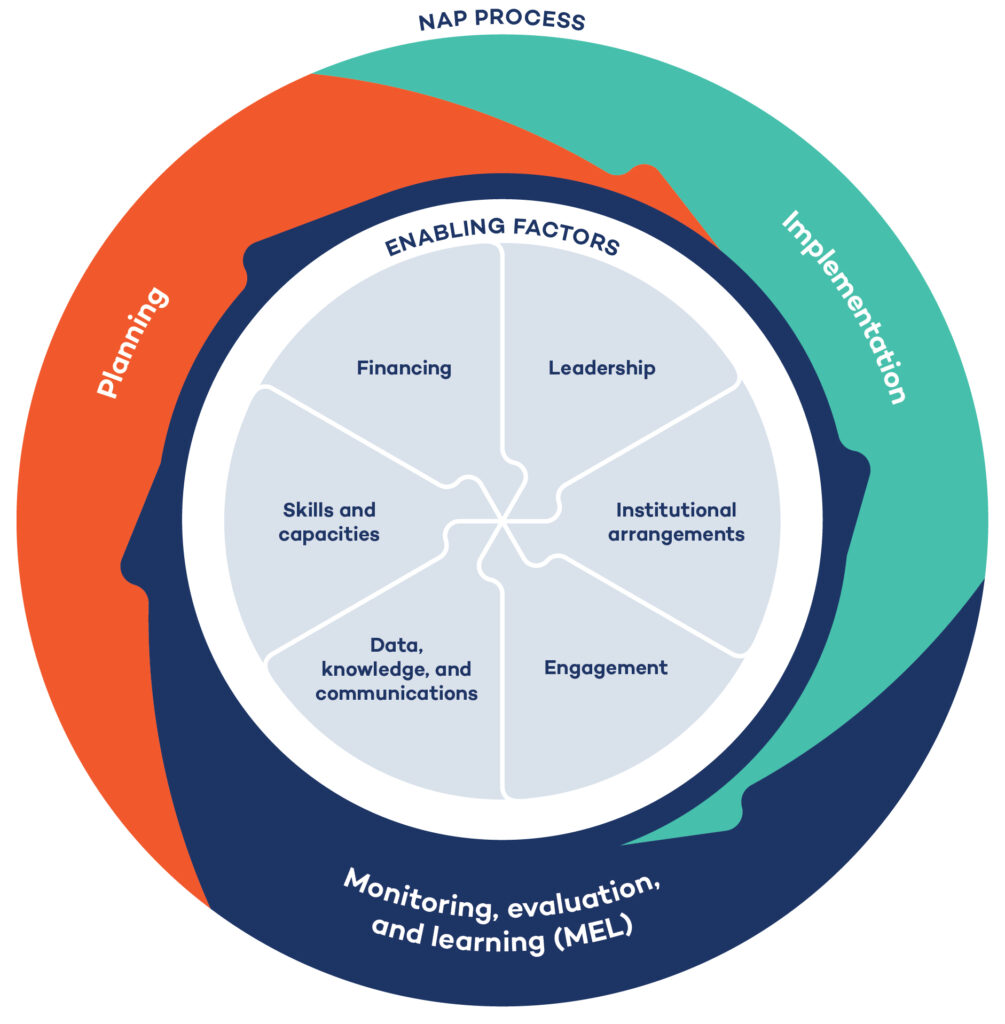NAP Process: The NAP Process Itself
-
What does the NAP process actually involve?
The NAP process can be thought of as three broad phases—planning, implementation and M&E—all of which are supported by capacity development, financing, appropriate institutional arrangements, and information sharing among the different actors involved. During the planning phase, climate-related vulnerabilities and risks are assessed, options for managing these risks are identified and prioritized, and strategies for their implementation developed. During the implementation phase, these strategies are fleshed out in greater detail, financing secured, and necessary technical and human resources procured and deployed. Progress, results and lessons from implementing the strategies are tracked and reported as part of M&E.
The technical guidelines for the NAP process developed by the Least Developed Countries Expert Group (LEG) note four elements to the NAP process: A. Lay the groundwork and address gaps; B. Preparatory elements; C. Implementation strategies; D. Reporting, monitoring, and review. These correspond to the three phases described above and shown below, with phases A and B corresponding to “planning,” phase C to both “planning” and “implementation” and phase D to “M&E.”
-
Wait, the NAP process is about more than planning?
Yes. It is a bit confusing since the word “plan” of course appears in “NAP,” but—as depicted in the figure above—the NAP process does involve more than just planning. Indeed, using the term, “NAP process” is an attempt to emphasize that adaptation planning leads to something more—namely, implementation of action on the ground.
While robust planning—from assessing vulnerabilities and risks, to prioritizing adaptation needs, to identifying capacity gaps—is the foundation for meaningful adaptation action, it cannot stop there. All the resources that are invested into developing good plans, strategies, and policies must be translated into tangible efforts that reduce the vulnerability of people and places to the impacts of climate change; this is also why producing a NAP document cannot be seen as the most important result of a NAP process.
-
Is the NAP a document or a process?
Both. But one of the most important things to emphasize is that national adaptation planning is a process—it is a continuous cycle of planning, implementation and monitoring and evaluation (M&E), adjusted over time based on feedback and lessons. That is, as countries discover what works and what does not work in their particular context, the NAP process should be improved.
Publishing a NAP document that presents the country’s approach and priorities for adaptation can be an important milestone in many countries’ NAP processes. But some countries may choose not to develop a new NAP document if, for example, they already have a policy document that sets out their climate change adaptation priorities. Still others are developing multiple documents over the course of their NAP process, which may include sector adaptation plans and/or strategies.
Whatever a country’s approach to producing a NAP document, it is important to note that it is just one step of the broader process. In other words, the NAP process does not end with a document. Countries that have completed NAP documents continue to invest in their NAP processes by regularly assessing climate risks, engaging stakeholders, building capacities, identifying sources of finance for implementation, tracking and reporting on their progress, and revisiting stated adaptation priorities.
-
But the NAP process is focused at the *national* level…right?
Yes, but sub-national actors have an important role to play!
Again, the word “national” in “NAP” would lead you to believe that the process is targeted solely at stakeholders and institutions operating at the national level—e.g., central or federal governments, sector ministries, departments, etc. This is not strictly the case, however.
Successful NAP processes create intentional and strategic linkages between national and sub-national adaptation planning, implementation, and M&E—we often use the term “vertical integration.”
Establishing and maintaining these national–sub-national linkages ensures that local realities are reflected in the NAP process and that the national-level process enables adaptation at sub-national levels, including at local or community levels. And while priorities may be identified through a nationally driven process, implementing actions to address them will inevitably involve sub-national actors such as local authorities and civil society organizations. Without these actors, it will be difficult to achieve adaptation outcomes on a broad scale.
-
How can a process that often involves creating separate adaptation plans also be about integrating adaptation into existing development planning and decision making?
Because priority setting and planning are important steps towards integration. The climate vulnerability and risk assessment process allows countries to identify and prioritize adaptation actions, which can then be integrated into its development plans and processes. Often, this involves the development of a separate adaptation plan; however this does not mean that a country has forgone integration. On the contrary, this provides a basis for stakeholders to understand what needs to be done, why and how—elaborating the what for integrating adaptation in plans, policies and budgets.
At the same time, countries are working to sort out the how—adjusting government procedures and processes to integrate climate change into decision making so that adaptation becomes part of everyday business.
These two processes may seem at odds with each other, but they can be mutually reinforcing and happen concurrently. This allows countries to move forward on identifying and addressing adaptation priorities, while also adjusting systems and decision-making processes to make adaptation a core part of a country’s approach to development. The iterative nature of the NAP process allows for this, providing countries with the flexibility to take a phased approach to integrating adaptation over time.
